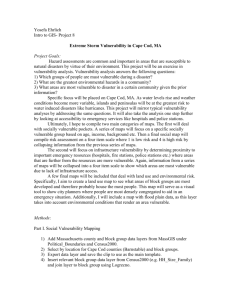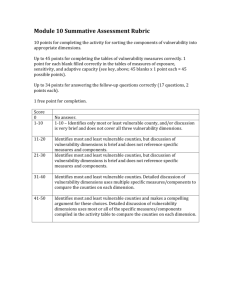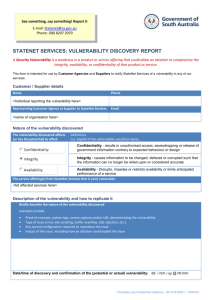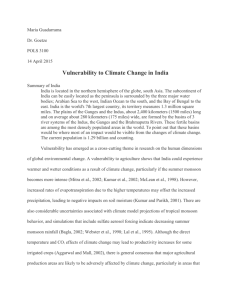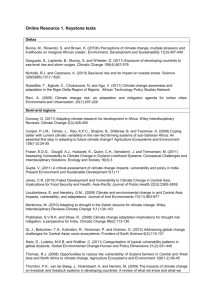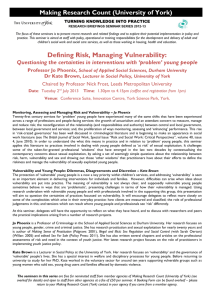Final Paper
advertisement
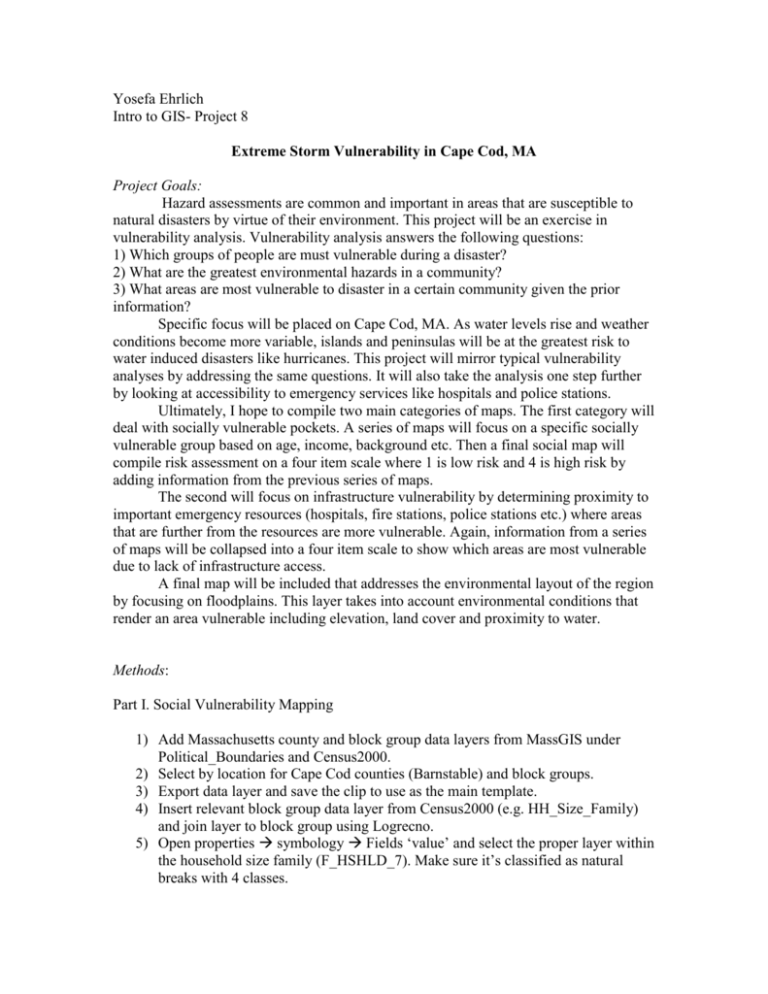
Yosefa Ehrlich Intro to GIS- Project 8 Extreme Storm Vulnerability in Cape Cod, MA Project Goals: Hazard assessments are common and important in areas that are susceptible to natural disasters by virtue of their environment. This project will be an exercise in vulnerability analysis. Vulnerability analysis answers the following questions: 1) Which groups of people are must vulnerable during a disaster? 2) What are the greatest environmental hazards in a community? 3) What areas are most vulnerable to disaster in a certain community given the prior information? Specific focus will be placed on Cape Cod, MA. As water levels rise and weather conditions become more variable, islands and peninsulas will be at the greatest risk to water induced disasters like hurricanes. This project will mirror typical vulnerability analyses by addressing the same questions. It will also take the analysis one step further by looking at accessibility to emergency services like hospitals and police stations. Ultimately, I hope to compile two main categories of maps. The first category will deal with socially vulnerable pockets. A series of maps will focus on a specific socially vulnerable group based on age, income, background etc. Then a final social map will compile risk assessment on a four item scale where 1 is low risk and 4 is high risk by adding information from the previous series of maps. The second will focus on infrastructure vulnerability by determining proximity to important emergency resources (hospitals, fire stations, police stations etc.) where areas that are further from the resources are more vulnerable. Again, information from a series of maps will be collapsed into a four item scale to show which areas are most vulnerable due to lack of infrastructure access. A final map will be included that addresses the environmental layout of the region by focusing on floodplains. This layer takes into account environmental conditions that render an area vulnerable including elevation, land cover and proximity to water. Methods: Part I. Social Vulnerability Mapping 1) Add Massachusetts county and block group data layers from MassGIS under Political_Boundaries and Census2000. 2) Select by location for Cape Cod counties (Barnstable) and block groups. 3) Export data layer and save the clip to use as the main template. 4) Insert relevant block group data layer from Census2000 (e.g. HH_Size_Family) and join layer to block group using Logrecno. 5) Open properties symbology Fields ‘value’ and select the proper layer within the household size family (F_HSHLD_7). Make sure it’s classified as natural breaks with 4 classes. 6) Open attribute table and create a new field (under the ‘options’ button on the bottom). Save as Fam_7_Plus. 7) Under the options tab click ‘select by attributes’ and set the field value (F_HSHLD_7) to less than the lowest 25% of the natural breaks. For example, if my the four classes break down to 1-5, 5-10, 10-15, 15-20 I would set F_HSHLD_7 < 5. 8) Whichever fields in the attribute table that apply to that characterization will be highlighted. Right click the new field- Fam_7_Plus, and click field calculator. 9) Set Fam_7_Plus = 1 to signify lowest vulnerability. 10) Repeat for the remaining 75% until you have classified all the data 1-4. 11) When finished, you can remove the join from the attribute table, so only the new field remains. 12) Repeat for all census information. 13) To create total social vulnerability map use field calculator to add together all the other fields created 14) Repeat above steps to divide information into quarters according to natural breaks, select by attribute for each quarter and then assign it to label 1-4 using field calculator. See field calculator image below. Field Calculator: Used to compile information across all infrastructure/ social vulnerability groups to form one big map of vulnerability. Same technique was used to create one overall vulnerability map across social and infrastructure. Part II. Infrastructure Vulnerability 1) Insert relevant layer file from M/State/MA/MassGIS/Infrastrucute (e.g. PoliceStations). 2) Select by location to the Cape Cod county block group (so that all the information stays in the same attribute table) and export the clip. Save clip under Hdrive_Final Project_ shp.file. (Cape_Cod_PoliceStation) 3) Add the layer and delete the original police station. 4) Activate spatial analyst by opening ‘tools’ ‘extensions’ and clicking ‘spatial analyst’. You can activate the tool bar under ‘view’ ‘toolbars’. 5) Open spatial analyst ‘options’ ‘distance’ ‘straight line’ 6) Under ‘distance to’ set it to Cape_Cod_PoliceStation and set the ‘cell size’ = 30 7) Open spatial analyst ‘options’ ‘zonal statistics’. Set ‘zone field’ = logrecno. Set ‘value raster’ = Distance to Cape_Cod_PoliceStation. Select ‘ignore NoData caluclations’ and ‘join output table’. Unselect ‘chart’. Save as PoliceStation_Dist (under zone_tables in H drive). Click OK 8) Open Cape_Cod_Blkgrp_LegAttrib attribute table. Under options (on bottom) add new field ‘Poli_Mean’ and set ‘type’ = double (because numbers have decimals). 9) Right click on the new field (Poli_Mean) and open field calculator. Set it = to PoliceStation.Dist_Mean (at the bottom of the options) by double clicking it. 10) Back in the attribute table add another new field under ‘Poli_Dist’. Set the type = short integer. 11) Back in data view right click Cape_Cod_Blkgrp_LegAttrib and open its properties symbology. Set field value to Cape_Cod_Blkgrp_LegAttrib. Poli. Mean. Make sure its broken into 4 classes under natural breaks. 12) Return to attribute table for Cape_Cod_Blkgrp_LegAttrib and under options click select by attribute. Set PoliceStationDist.Mean< 5 (as explained above it’s the lowest 25%) 13) Left click new field Poli_Dist and select field calculator. Set it to = 1 to signify lowest vulnerability. 14) Return to attribute table and click options- select by attribute again. This time set Poli_Dist >=5 AND Poli_Dist < 10. \ 15) Repeat the same procedure with field calculator only set it = 2. 16) Repeat for the remaining 75% until you have classified all the data 1-4. 17) When finished, you can remove the join from the attribute table, so only the new field remains. 18) Repeat for all infrastructure information. 19) To create total infrastructure vulnerability map use field calculator to add together all the other fields created. 20) Repeat above steps to divide information into quarters according to natural breaks, select by attribute for each quarter and then assign it to label 1-4 using field calculator. Refer to field calculator image above. Part III. Floodplains 1) Insert floodplains layer as designated below. 2) Include SFHA layer (determines whether an area is in or out of the floodplain) 3) Select by attribute for ‘IN’ Data Layers (includes file location and year the data represents): Social Vulnerability: (2000 census data) % 65 + # of Households with 7 + people % Low Income # of Non-English households % 18 – # of HsHlds built before 1959 % Minority # of Male Population 25+ with high school diploma # of Female Population 25+ with high school diploma # of workers 16 + who commute to work by car/ van/ or truck Infrastructure: Schools Police stations Hospitals Airports Fire stations LegAttrib LegAttrib LegAttrib LegAttrib LegAttrib CEN2K_BG_HOUS_STRUCT_AGE LegAttrib CEN2K_BG_ED_ATTAIN_GEN_AGE M_HSGRAD CEN2K_BG_ED_ATTAIN_GEN_AGE F_HSGRAD CEN2K_BG_TRNS_COM_MEANS CTV M/State/MA/MassGIS/ Infrastructure (December, 2007) M/State/MA/MassGIS/ Infrastructure (February, 2007) M/State/MA/MassGIS/ Infrastructure (January, 2004) M/State/MA/MassGIS/ Infrastructure (June, 2006) M/State/MA/MassGIS/ Infrastructure(February, 2007) Environmental Vulnerability/ Land Use: Flood zones MassGISRegulated_AreasFEMA Q3 FloodSFHA (July 1997) Difficulties and Limitations: If a project of this sort were to be executed professionally where results would bear real-life consequences, several further steps should be taken. First, accuracy of data was never determined. Since a goal of this project is to develop a visually accurate map of what areas are most vulnerable, accuracy is an important consideration. Assuming city planners were to look at distance from certain emergency services, having inaccurate data about the location of a hospital could lead to misplacement of roadblocks or inappropriately cleared lanes in a highway. However, the census information does not require positional accuracy. What it does require to be considered valid is current data. All the census information is nearly 9 years out of date, as data was compiled from the 2000 Census. This can seriously mislead city planners. Most of the infrastructure information is relatively current (within the last 4 years), but the floodplain data is nearly 12 years old. In this time period many more surfaces may have been paved for development thereby affecting flood plain area limits. A more professional assessment may want to look at more recent information. Another logistical limitation of this project is that in determining distances from various infrastructure sites, I used the spatial analyst ‘straight line’ feature. This tool measures the distance from a given point and rates areas on a continuous scale based on those distances. The concern here is that this distance is measured by a straight line from the point of interest. Due to the triangular shape of Cape Cod, where the peninsula almost curves in on itself, it would be impossible for residents of the northernmost tip to drive straight down to the base of the peninsula without drowning. Clearly the straight-line measurement is inadequate and underestimates actual distances. A third limitation of this kind of project is that all the information was determined by block group. Unfortunately, it is impossible to tell where specifically in the block group people of a certain demographic are most concentrated, since the vulnerability rating is spread across the entire block group area. In a real emergency situation this may lead emergency service people astray in location hazard areas. A more theoretical concern resulting from this project is that in assembling the total vulnerability maps, all the variables were weighed evenly. However, in actuality some variables contribute more heavily to vulnerability than others. For instance, low level of attained education does not render someone as vulnerable as stark poverty. Many people complete their education after high school and go on to live successful lives. Living below the poverty line, though, makes all aspects of life extremely difficult, especially in light of extreme storms or disasters. Considering these two variables equally in determining the total social vulnerability map is doing a disservice to the people who are at greater risk. Another more abstract point is that some of the variables are of questionable importance to vulnerability. For instance, populations who commute to work by car/truck/van are in some ways more vulnerable and in others less. Spending a portion of your day on the road makes you vulnerable in the event that an extreme storm hits during rush hour while people are trapped in their cars behind lines of traffic. They are also more likely to get into automobile accidents during sour weather conditions. Conversely, assuming these commuters own cars places them at a greater advantage over some other demographics. Prior to extreme storms, this pocket of society may have the foresight (and capability) to drive themselves and their families out of the area until the weather calms. This assessment presented this variable linearly and was incapable of expressing its multi-faceted nature. Conclusions and Future Research Directions: By looking at the two total vulnerability maps it seems they are nearly mirror images of one another. It would seem that the areas at the highest infrastructure risk are at the lowest social risk and vice versa. Such a polarization of vulnerability may make it difficult for city planners to isolate a particular area to fully service; however, it provides them with the opportunity to address regions by their needs. In fact, this may prove more efficient, since planners can allocate their resources very specifically between block groups. For example, considering the “arm” seems at a low social vulnerability risk but at an extremely high infrastructure vulnerability risk, during an emergency situation, planners could ensure that an exit route is available for “arm” residents but that services like clean water and English translators are provided for resents in the more southern/ central region of Cape Cod. In the future, such an analysis may want to control for the logistical and theoretical shortcomings and limitations of this assessment listed above. Perhaps accuracy and currency should be determined and assessed prior to use of any data layers. Further, variables should be weighed according to degree of vulnerability. Finally, future research into this area may want to take advantage of statistical tools available through GIS and SPSS or other statistics software programs. Determining percents of people at risk may help in deciding which regions of Massachusetts are at highest risk and therefore require the most aide and attention during an emergency. Ultimately, future research should add more variables to attain a more complete understanding of vulnerability so that in an emergency situation people are best helped at their level of need. Completed Maps: Infrastructure Vulnerability Maps: Social Vulnerability Maps: Total Vulnerability (across social and infrastructural variables): Floodplains:
